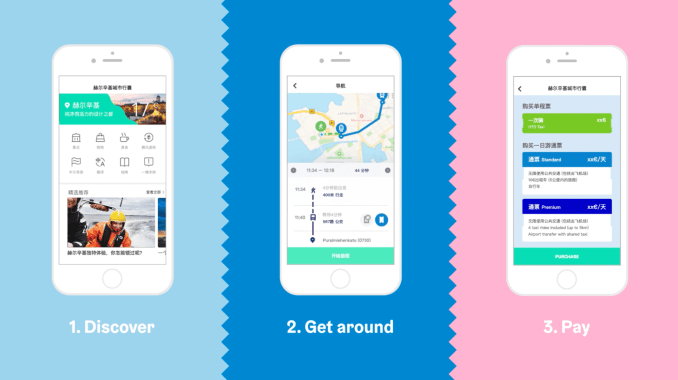When people travel, they usually have a list of apps installed to navigate a new city, find restaurants, book transit tickets and more. China’s top chat app WeChat has designs on claiming that spot with a new strategy that lumps all these functions into a collection of destination-specific apps.
Operated by Tencent, Asia’s second most valuable tech giant, WeChat is a so-called “super app” defined by the myriad of services it hosts ranging from ride-hailing and food delivery to e-commerce and payments. Its efforts to dominate China received a huge boost back in 2017 when it launched “mini programs”, easily-downloadable apps that provide stripped-down but essential functionality. Millions of these lite apps are serving WeChat’s one billion users today, and WeChat is now adding travel to the list of needs it addresses.
One of WeChat’s first attempts at aiding tourism is a mini app called “MyHelsinki”, a collaboration between Tencent, mobility startup Whim, the city of Helsinki and other partners. In effect, the WeChat-powered app is a hybrid of Lonely Planet, Yelp, Google Translator, Uber and an e-wallet for Chinese tourists who visit the Finnish capital, and it has plans to replicate the system elsewhere in the world.
Helsinki was picked as an early laboratory because of its “compact size, well-functioning infrastructure and the cluster of highly-educated tech professionals,” Whim co-founder Kaj Pyyhtia told TechCrunch via email. Drawn by Northern lights and the region’s minimalistic designs, Chinese travelers are flocking to Scandinavia. Denmark saw a 120% surge in number of Chinese tourists last year while Denmark went up 70%, according to a joint report (link in Chinese) by Ctrip and China Tourism Academy.
What makes MyHelsinki so powerful is that it is quick to reach. From WeChat’s main interface — which resembles any other messenger out there — users scroll down to unfold a hidden menu of mini programs, where they can find MyHelsinki.
What follows is a myriad of options that let users discover attractions, shops and restaurants; plan routes and buy bus and subway tickets (and soon hail taxis, rent cars and ride city bikes); find a translator-cum-travel guide or simply use WeChat’s built-in translator; as well as request a tax refund. There’s also an emergency button that’s linked to the local police station and the Chinese embassy.

Screenshot from MyHelsinki demo video. Source: Idean
The scope covered by the mini app ensures users rarely have to leave WeChat to access all of these disposable services for the trip, although Tencent has repeatedly emphasized it didn’t design mini programs to replace native apps but be complementary or even drive traffic to the full-on versions. The inspiration for MyHelsinki looks to be a similar mini app that WeChat created for Yunnan, a southwestern province in China that’s known for its beautiful landscapes and heritage sites.
“The number of Chinese visitors traveling overseas is growing rapidly and travel patterns are in real transition. Among those travelers in-depth traveling has become a trend. With Helsinki mini program, a comprehensive and reliable one-stop service, Tencent wants to serve them as well as possible,” Zhan Shu, general manager of the Tencent Governmental Affairs and Tourism Center, said in a statement.
The travel service can potentially increase usage for WeChat’s e-wallet as it expands. For the last few years, WeChat Pay has been in a fierce payments war with Alipay, the digital wallet owned by Alibaba’s financial affiliate Ant. Now the battle is increasingly being fought out overseas. Indeed, Alipay made its foray into the Nordic region two years ago by enabling local merchants to accept its scan-to-pay method that’s become ubiquitous in China.
Third wave of Internet
Aside from checking the “travel” box for its universe of mini apps, the MyHelsinki initiative also underscores Tencent’s push into aspects of life beyond the Internet. AOL co-founder Steve Case famously suggested we are at the start of the “Third Wave”, the stage where the center of gravity shifts to integrating software into healthcare, agriculture, education, transportation and other “real world” sectors.
China’s tech theorists call this the “Internet-plus” era, and almost no company has been a more active advocate of the concept than Tencent. The company’s pivot to digitize traditional industries is inevitable. Aside from the visible allure of a new high-growth space, Tencent has become more attuned to the needs of enterprise clients after its core revenue stream in consumer-facing video games was caught up in Beijing’s tightened oversight of the entertainment sector in China.
“Tencent is transforming itself from a gaming company to an industrial internet giant that could be the first in the world to embrace online to offline experience in its full potential. For Tencent smart tourism is one of the main platforms to develop this further,” Tia Hallanoro, director of brand communications and digital development at Helsinki Marketing, a marketing firm run by the city of Helsinki, told TechCrunch via email.
“Some of the new key focus areas for Tencent are smart tourism, smart retail and cloud services as the three are interconnected,” Hallanoro added.
Public-private effort
As Case pointed out during an interview with Wired back in 2016, companies riding the Third Wave need to collaborate with more established corporations and local governments as the latter players are more resourceful in the tangible world. That’s what has shaped MyHelsinski.

Screenshot from MyHelsinki demo video. Source: Idean
While most of Tencent’s mini apps are made by third-party companies, MyHelsinki is one of the rare products born out of collaboration between the Chinese company and outside partners, in this case, Whim, which itself runs an aggregator of mobility services in Antwerp, Birmingham, the U.K., Helsinki and Vienna; Idean, a global design agency; Avaintec, a Finnish software design firm; and lastly, Helsinki Marketing.
When it comes to the division of labor, Tencent has led the production of all development phases, according to Hallanoro. Underpinning the mini app is a set of open data maintained by Helsinki Marketing, which offers up-to-date information about the city’s locations, events and activities. Idean, on the other hand, manages service design with Tencent. Whim’s parent company MaaS Global is responsible for integrating Whim’s mobility services. And Avaintec worked with MaaS Global to configure WeChat Pay as the payment method through which users can settle purchases in yuan.
When a user places a request, the MyHelsinki app calls Whim’s API for the service, and Whim, in turn, calls for the corresponding third-party service provider, again through an API. Whim then feeds the information back into the mini app, be it a ticket for the public transportation, or a taxi that would already have been paid for.
That’s just the beginning. Helsinki Marketing is currently working with Tencent and Finland’s flagship carrier Finnair to add flight bookings to the mini program later this year, said Hallanoro. Meanwhile, Whim, which itself is crossing the Atlantic to launch in the United States, said that it welcomes opportunities to roll out the mini program experience in other parts of the world after the “successful launch in Helsinki,” according to Pyyhtia.
“The idea is to make all of the services or inventory available in Whim, also available within the mini program,” said Hallanoro. “As our coverage expands city to city and country to country, already this year, we hope to continue to also support Tencent making transportation available across the world as well.”
